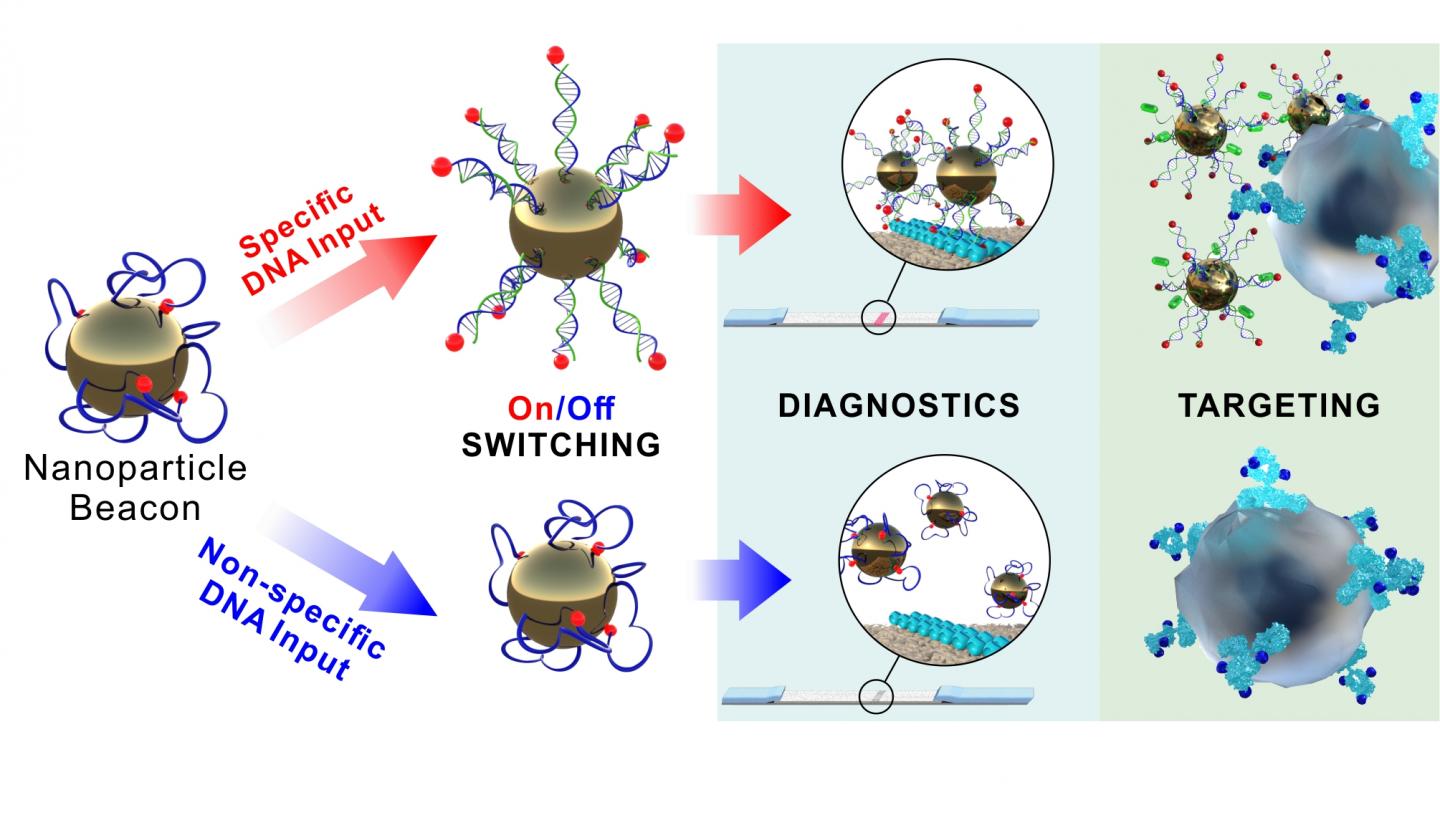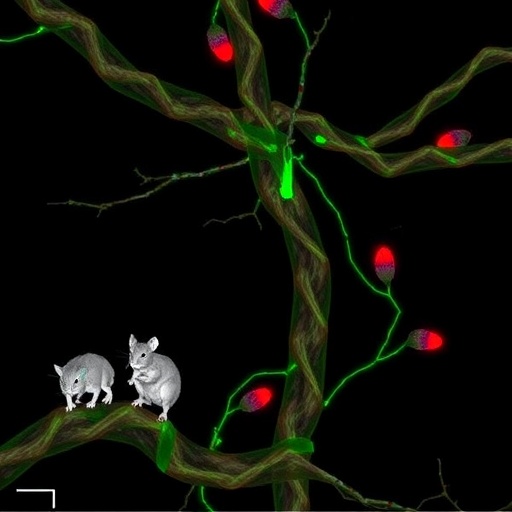
Credit: Vladimir Cherkasov et al./ACS Nano
In 1900, German physician Paul Ehrlich came up with the notion of a “magic bullet.” The basic idea is to inject a patient with smart particles capable of finding, recognizing, and treating a disease. Medicine has pursued the magic bullet ever since.
Russian researchers from the Moscow Institute of Physics and Technology and Prokhorov General Physics Institute, RAS, have made headway toward that goal. Led by MIPT’s Maxim Nikitin, the team published a paper in ACS Nano (impact factor: 13.903), presenting a smart material with unique properties, which holds promise for express DNA analysis and next-generation drugs against cancer and other serious diseases.
Delivering medications to the cells affected by a disease is a major bottleneck in diagnostics and therapy. The drugs should ideally reach the pathogenic cells only, without doing any harm to the healthy ones. There are a range of marker compounds that give away cancer cells. Among these telltale molecules, found on the surface of the affected cells or in their microenvironment, are waste products and those sent to other cells as signals.
Modern drugs rely on one such marker to identify sick cells. However, it is usually the case that healthy cells carry the same markers, albeit in smaller quantities. This means the existing targeted drug delivery systems are not perfect. To make drug delivery more specific, smart materials are required that are capable of analyzing multiple environment parameters at once, seeking out the target with a greater precision.
“The conventionally used methods for drug delivery are like sending a letter with the city and street written on the envelope, but without the house and apartment numbers,” principal investigator and the head of MIPT’s Nanobiotechnology Lab Maxim Nikitin commented. “We need to be able to analyze more parameters to ensure effective delivery.”
Previously, Nikitin and co-authors developed nano- and microparticles capable of conducting complex logic computations via biochemical reactions. In their 2014 paper in Nature Nanotechnology, the researchers reported that their autonomous nanocomputers could analyze many parameters of a target and were therefore much better at its identification.
The past few years have seen many advances in biocomputing materials. By 2018, hundreds upon hundreds of papers had been published on the subject. Chemical Reviews, the field’s most reputable journal with an impact factor of 54.301, published a review of contemporary nanorobotics and biocomputing. The paper, with the subtitle “Dawn of Theranostic Nanorobots,” was authored by researchers from MIPT’s Nanobiotechnology Lab and the Biophotonics Lab of Prokhorov General Physics Institute of the Russian Academy of Sciences (RAS).
Despite the efforts of numerous research teams around the world trying to expand the functionality of biocomputing materials, they are still not sensitive enough to disease markers, rendering practical applications impossible.
The recent paper of the team in ACS Nano marks a breakthrough in this field. They have developed a unique smart material characterized by supersensitivity to DNA signals. It is several orders of magnitude more sensitive than the closest competitor. Moreover, the new material exhibits a higher sensitivity than that of the vast majority of currently available express DNA assays.
The researchers achieved that remarkable result after they discovered that DNA molecules exhibit unusual behavior on the surface of nanoparticles.
In the study, one end of a single-stranded DNA molecule was pinned to a nanoparticle. Importantly, the molecule had no hairpins — that is, double-stranded segments where part of the chain sticks to itself. The team outfitted the other end of the DNA chain with a small molecular receptor. Contrary to expectations, the receptor did not bind its target. After ruling out a mistake, the scientists hypothesized that single-stranded DNA might stick to the nanoparticle and coil up, hiding the receptor beneath it, on the particle’s surface (fig. 1, left).
The hypothesis proved right when the team added complementary single strands of DNA to their particle (fig. 1, right). The receptor instantly became active, binding its target. This happened because the bonds between the complementary nucleotides caused the two DNA strands to form a rigid double helix, or duplex. Like a chameleon’s tongue, the strand uncoiled, exposing the receptor for target binding.
Such uncoiling of the DNA strand resembles that of a molecular beacon (fig. 2, top). This refers to a single-stranded DNA whose one end forms a duplex with the opposite end, folding up the structure. A complementary strand of DNA can unfold the beacon. However, there is a significant and useful distinction. “Unlike molecular beacons, the discovered phenomenon enables tuning the force of DNA curling on the nanoparticle separately from the straightening force of input DNA. This leads to dramatically better sensitivity to the input,” noted the study’s first author Vladimir Cherkasov, a leading researcher at the Nanobiotechnology Lab, MIPT.
In their paper, the researchers demonstrate agents capable of detecting DNA concentrations as low as 30 femtomoles (30 billionths of a millionth of a mole) per liter, without DNA and/or signal amplification. The study’s co-author Elizaveta Mochalova, a doctoral student at MIPT’s Nanobiotechnology Lab, added: “We showed the sensitivity to be so high with a quite simple lateral flow assay, which is widely used in pregnancy tests. Unlike the existing DNA assays, such tests can be performed outside a clean laboratory setting and require no advanced equipment. This makes the technology well-suited to rapid infectious disease screening, food testing kits for home use, and similar things.”
The authors of the paper have also showed the technology to be applicable to the design of smart nanoagents that would recognize cancer cells based on the concentration of small DNA in their microenvironment. Not long ago, small nucleic acids were thought to be just meaningless debris resulting from the recycling of larger functional molecules. However, small RNAs turned out to be key regulators of many processes in living cells. Biologists are currently identifying disease markers among these RNAs.
“Interestingly, the smaller the length of the nucleic acid to be detected, the more competitive our technology becomes,” Nikitin commented. “We can fabricate ultrasensitive agents controlled by well-studied small RNAs that are 17 to 25 bases long. However, if we take sequences that are less than 10 nucleotides long, there are simply no technologies with comparable sensitivity.”
“What’s even more exciting is that our method enables probing the microenvironment of cells to determine whether shorter small RNAs are useful disease markers rather than the meaningless compounds they are commonly held to be due to the difficulties in their detection,” the scientist added.
The newly developed technology offers prospects for genomics, both in terms of express point-of-care DNA assays and for developing next-generation therapeutic nanomaterials. The recent years have seen immense breakthroughs in genome research and editing, but the new technology could solve the problem that remains relevant: delivering drugs only to the cells with a particular microenvironment genetic profile.
The researchers plan to continue developing their technology. This includes future work at MIPT’s recently established Center for Genomic Technologies and Bioinformatics.
###
Media Contact
Ilyana Zolotareva
[email protected]
897-777-14699
Original Source
https:/
Related Journal Article
http://dx.





